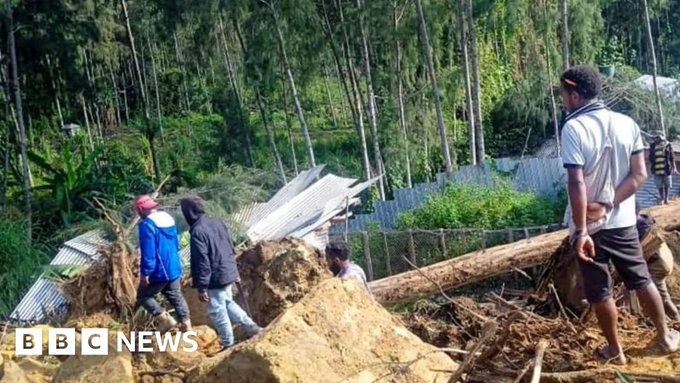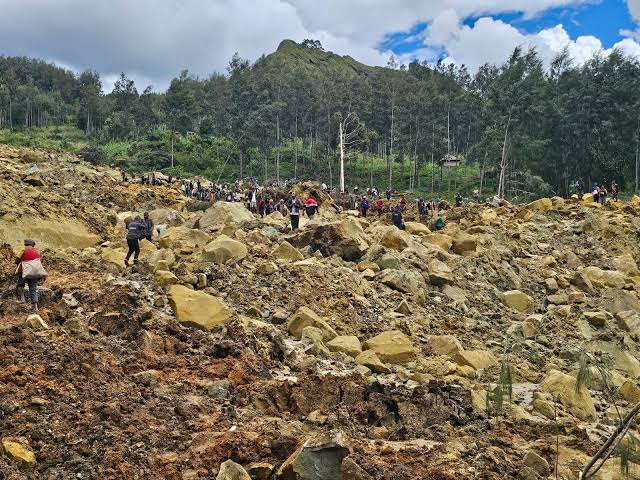
Magnitude of the Disaster

More than 670 people are feared dead following a massive landslide that struck a remote village in the Enga province of Papua New Guinea. ( The landslide occurred in the early hours of Friday morning, burying over 150 houses and an estimated 670 people under several meters of soil, rocks, and debris. The UN migration agency in Papua New Guinea has revised the initial estimate of over 100 deaths, stating that the actual death toll is likely to be much higher.
Causes and Contributing Factors
The landslide was triggered by heavy rainfall that has saturated the region in recent weeks. Papua New Guinea is known for its high-rainfall climate, with the highlands region experiencing the heaviest downpours. The mountainous terrain of the country, combined with its location along the Pacific Ring of Fire, further contributes to the country’s susceptibility to landslides.
Geological factors such as the deeply weathered and tectonically active landscape of Papua New Guinea play a significant role in the frequency and severity of landslides in the region. The country’s steep terrain and tropical climate lead to increased erosion, flooding, and higher tides, all of which raise the chances of dangerous rockfalls and landslides.Additionally, the regular occurrence of significant earthquakes in the area can trigger landslides and weaken rock slopes.
Human activity, such as deforestation and mining operations, has also exacerbated the landslide risk in Papua New Guinea. The removal of forest cover destabilizes the landscape, making it more prone to landslides. Large-scale mining and logging activities in the region have further contributed to the environmental degradation and increased vulnerability to natural disasters.
Rescue and Relief Efforts
The rescue and relief efforts in the affected area have been hampered by the remote and difficult terrain, as well as by damage to the main roads and infrastructure. Parts of the affected region are only accessible by helicopter, and the blocked roads have made it challenging for emergency responders to reach the disaster site.
Despite these obstacles, a group of rescuers has managed to reach the affected area. The local emergency response team has so far retrieved three bodies and provided medical assistance to six survivors, including one child. However, the conditions on the ground remain extremely dangerous, with the land still sliding and rocks continuing to fall, posing a significant risk to the rescue workers.
Efforts to reach and assist the affected communities are further complicated by the outbreak of tribal violence in the nearby Tambitanis village. The violence, which is unrelated to the landslide, has resulted in the deaths of eight people and the burning of 30 homes and five businesses. This has forced the Papua New Guinea military to provide security escorts for the aid convoys traveling to the disaster site.
Humanitarian Response and Challenges
The United Nations, along with various government agencies, non-governmental organizations, and the Papua New Guinea Defense Force, have mobilized to coordinate the relief and recovery efforts. An Emergency Response Coordination Team has been established, comprising representatives from the Enga Provincial Disaster Coordination Office, the Department of Health, the Department of Provincial Works, the police, and the Defense Force.
The immediate priorities of the humanitarian response include the provision of food, shelter, and medical supplies to the affected communities. The government is also working to establish temporary evacuation centers on safer ground to accommodate the displaced residents. As of Sunday, more than 1,250 people had been displaced by the disaster, with many taking refuge with relatives and friends in nearby areas.
However, the recovery and search efforts have been hindered by the scale of the destruction and the unstable conditions on the ground. The landslide has created a debris field spanning the size of three to four football fields, with some areas buried under up to 8 meters of soil, rocks, and debris. This has made it extremely difficult for rescue teams to locate and recover the bodies of those trapped beneath the rubble.
Additionally, the remote location of the affected area and the lack of available heavy machinery have further complicated the recovery efforts. The community has also requested that excavators not be used until they have had the opportunity to mourn and grieve their lost loved ones.
Broader Implications and Challenges
The landslide disaster in Papua New Guinea has highlighted the vulnerability of the country’s rural and remote communities to the impacts of natural disasters. With a largely rural population and limited infrastructure, these communities often lack the resources and support necessary to effectively respond to and recover from such events.
The long-term consequences of the landslide will be far-reaching, affecting not only the immediate victims and their families but also the broader social and economic fabric of the affected region. The destruction of homes, food gardens, and critical infrastructure, such as health facilities, will have a significant impact on the livelihoods and well-being of the affected communities.
Moreover, the landslide disaster has the potential to exacerbate existing social and political tensions in the country. The outbreak of tribal violence in the nearby Tambitanis village, while unrelated to the landslide, underscores the fragility of the region and the challenges faced by the government in maintaining security and stability.
Conclusion
The devastating landslide in Papua New Guinea’s Enga province has resulted in a catastrophic loss of life, with the UN migration agency estimating that more than 670 people may have been buried under the debris. The disaster has exposed the vulnerabilities of the country’s rural communities, which are often ill-equipped to cope with the impacts of natural disasters.
The rescue and relief efforts have been hindered by the remote and dangerous terrain, as well as the ongoing threat of further landslides and tribal violence. However, the coordinated efforts of the government, international organizations, and local communities have been crucial in providing immediate assistance and support to the affected populations.
As Papua New Guinea continues to grapple with the aftermath of this disaster, it is essential that the international community lend its support and expertise to help the country build resilience and better prepare for future natural disasters. This will require a multifaceted approach that addresses the underlying environmental, social, and infrastructure challenges that contribute to the country’s vulnerability to such events.Sources:







